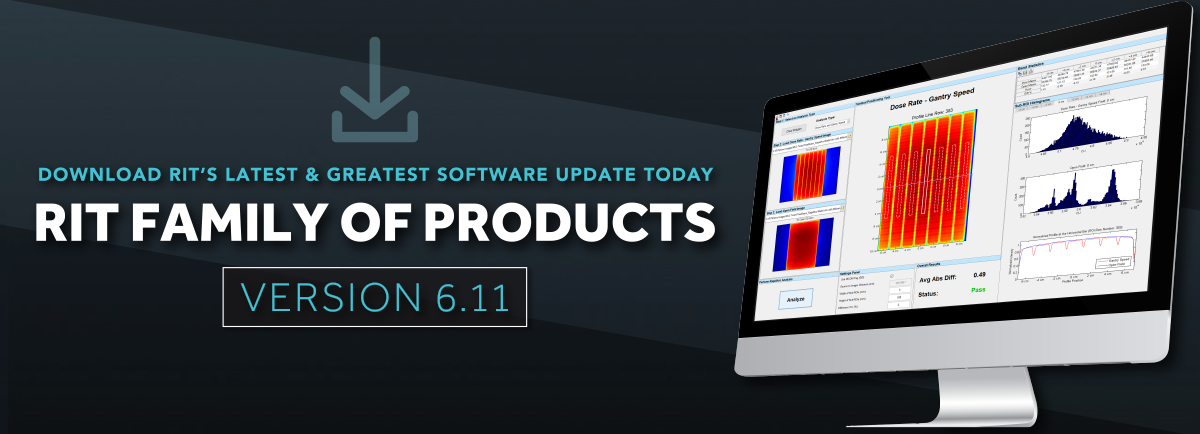Machine QA
RIT provides extensive machine QA capabilities, including comprehensive software packages that can be used to perform a full suite of measurements in accordance with TG-142 (including MPPG 8.b), TG-148, and/or TG-135 recommendations, and our popular 3D Winston-Lutz test for Isocenter Optimization. RIT’s automated routines allow you to perform daily, monthly, and annual QA with efficiency and precision, all while giving you confidence knowing your delivery performance is optimized.
SRS/SBRT QA
Isocenter Optimization Routine (3D Winston-Lutz)
Now with accuracy surpassing sub-pixel resolution!
The RIT Family of Products come equipped with an automated 3D Stereotactic Alignment routine to give you a fast and accurate measurement of isocenter accuracy, allowing you to optimize your SRS/SBRT delivery. Automatically process a range of 3 to 16 EPID Winston-Lutz images for fast, sub-pixel level accuracy of isocenter position. This routine allows physicists to perform daily or patient-specific analyses using specific clinical treatment angles. Using only a set of EPID Winston-Lutz images, the RIT system will calculate deviations between radiation and mechanical isocenter, determine ball/BB setup error, and suggest couch alignment adjustments to optimize your system’s accuracy. Additionally, this routine enables individual component (gantry, collimator, couch) characterization to better understand distinct contributions to isocenter deviation, giving insight into adjustments that can be made to improve delivery performance, if needed. RIT's Isocenter Optimization routine allows for optimal cone detection, resulting in the utmost precision.
Eliminate your need for films and increase your accuracy using Virtual Star Shot* with ANY combination of angles, reconstructed using a set of Winston-Lutz images in its dedicated window! Patents: US 9192784, JP 6009705, CA 2918045, and other international patents pending.
Recently-Added Enhancements:
- Isocenter Optimization for Elekta Unity
RIT’s popular 3D Winston-Lutz (Isocenter Optimization) routine now supports analysis on the Elekta Unity machine, an MR-LINAC machine that combines diagnostic quality MR imaging with a linear accelerator. Elekta users can now utilize RIT’s most popular analysis routine to automatically process a set of EPID Winston-Lutz images for fast, sub-millimeter accuracy of isocenter position. - Automated File Name Generation
RIT's 3D Winston-Lutz routine now includes the new Automated File Name Generation feature. The file name for PDF and ASCII analysis results will be automatically exported and generated with a timestamp and pass/fail status of results. This will save users time and improve workflow efficiency. - Updated Interface
When analyzing a range of 3 to 16 images with RIT’s 3D Winston-Lutz routine, all images are now featured in the same interface window. This eliminates the need for any scrolling and ensures a comprehensive picture of your analysis results, all in one place. - More Flexible Pass/Fail:
Users may now choose to pass or fail on the Maximum Machine Deviation (R) or the Total Maximum Deviation (W), which includes the ball setup error
TG-142

The single-vendor solution that performs or trends every image-based test recommended in TG-142 and MPPG 8.b
RITG142 enables you to use your EPID for many machine tests with confidence and ease for comprehensive QA in accordance with AAPM TG-142 and Medical Physics Practice Guideline (MPPG) 8.b. In addition, imaging QA phantoms are automatically scored with easy to use tracking and trending functions.
Features
- IGRT Daily QA
- CBCT imaging for OBI and XVI
- Planar kV Imaging
- Planar MV (EPID) Imaging
- Enhanced 3D Stereotactic (Winston-Lutz) with Virtual Star Shot, optimizing SRS/SBRT delivery (US Patent 9192784, JP Patent 6009705, CA Patent 2918045 and other International Patents pending)
- MLC accuracy
- Radiation vs. Light Field (Regular and Asymmetrical)
This Radiation vs. Light Field routine measures how well radiation and light field positions coincide for conformance with TG-142 recommendations. The routine can make use of EPID images of the radiation field and can adapt to a variety of SIDs, asymmetric, and custom field sizes. Besides radiation-light field coincidence, the routine measures field symmetry and flatness, penumbra width, and field edge orthogonality in vertical and horizontal directions. - Classic Star Shot Analysis
- Beam profiles / Flatness / Symmetry and more

Fully-Automated Star Shot Analysis
RIT’s film Star Shot beam detection routine has been completely re-designed and now features a fully-automated interface with more robust and accurate detection algorithms. A few key highlights include:
- Full Automation: Increase your efficiency and accuracy with RIT's one-click analysis of Star Shot images. The new algorithm removes pre-processing from your workflow, allowing for quicker acquisition of results. Polarity, ROI, number of spokes, and spoke center are all automatically extracted from the image, then applied in the analysis.
- Visualized Spoke Detection: Newly-added beam center overlays on the beam profile plots provide a clear indication of the automated routine’s performance.
- Artificial Intelligence: The re-designed routine utilizes sophisticated AI algorithms for even more accurate and reliable measurements. The AI obtains a 99% accuracy rate of spoke detection in a wide range of Star Shot images.
- Manual Override Option: If desired, the routine will also allow you to easily modify the settings to fine-tune the automated analysis by hand.

EPID Phantom Tests
- Constancy in 5 areas
- Resolution (MTF)
- Geometric Distortion
- Uniformity
- Contrast
- Noise

TG-148

The Best Source for Helical TomoTherapy® and Radixact® QA
RITG148+ is a precise, state-of-the-art, and comprehensive software built to perform all machine and imaging QA analyses for helical TomoTherapy®. Designed with the TG-148 report in mind, RITG148+ analyzes the standardized tests, including Static & Rotational Output Consistency, Jaw Centering & Alignment, Overhead Laser Positioning, Interrupted Treatment, and all others recommended for daily, monthly, and annual QA. RITG148+ also analyzes image quality, using the Tomotherapy Cheese phantom.
RITG148+ software's combination of powerful, robust routines in a user-friendly interface maximize the efficiency and precision of all measurements. For added convenience, users can easily create PDF reports for all routines, as well as export their data to the RITtrend™ database for large-scale analysis over time.
Recent Enhancements:
- Static Gantry and Helical Gantry Angle Invariance
The Static Gantry Angle and Helical Gantry Angle analyses have been revised to improve the rotational invariance. In RIT's updated software, rotation of these images is no longer needed. - Increased Overhead Laser Flexibility
The Overhead Laser analysis can now handle smaller films in RIT's updated software. A full 12.8"x17" film is no longer required in order to perform this analysis.

Image courtesy of Accuray | ©2017 Accuray Incorporated. | All Rights Reserved.


Automated Machine QA Tests
Please note that bold text below indicates the test name according to Accuray, and the test name in parenthesis is the corresponding test name in TG-148.
- Beam Planarity and Jaw Twist (Y-Jaw Divergence/Beam Centering and Y-Jaw/Gantry Rotation Plane Alignment)
- MLC Twist and Center of Rotation (MLC Alignment)
- Jaw Symmetry (Treatment Field Centering)
- Couch Travel Distance (Couch Translation/Gantry Rotation)
- Overhead Laser Position (Laser Localization)
Overhead Laser analysis can now handle smaller films in RIT's updated software. A full 12.8"x17" film is no longer required in order to perform this analysis. - Helical Gantry Angle (Gantry Angle Consistency)
This analysis has been revised to improve the rotational invariance. Rotation of images is no longer needed. - Static Gantry Angle
- Interrupted Treatment
- IGRT Alignment
- Import TomoTherapy® DICOM Film Files
- Import TomoTherapy® Calibration Files
- Vidar TIFF Export
Image Quality Tests
- CT Number to Density
- Uniformity
- Resolution
- Contrast
- Noise
- Geometric Accuracy
- Geometric Distortion
- Crop images with Pin Prick, Erase and ROI tool
Built-In Features
- RITtrend™ statistical database for reporting and trending
- PDF reports for every analysis routine
TG-135

Assembled to coincide with recommended QA tasks outlined within TG-135, RITG135 is a new, dedicated software package for all CyberKnife® Machine QA. These automated routines and analyses ensure rapid results, without compromising measurement precision.
RITG135 includes analyses for the End-to-End, AQA, Iris, Laser Coincidence, and M6 MLC Tests. Designed to simplify and enhance current methods for performing these routine tasks, RITG135 provides a user-friendly interface with minimal user interaction, reducing the likelihood of errors and ensuring reproducible measurement templates. Automated film detection algorithms eliminate the need for manual manipulation or alignment of images, significantly reducing the time needed to perform these tests. Easily create PDF reports for either individual or combined routines, and export to our RITtrend™ database for simple tracking and trending of results over time.
Fully-Automated Machine QA Tests
- End-to-End Test:
- Ball Cube 2 phantom (Fully-automated; No film flipping or mirroring needed)
- Ball Cube phantom
- Mini Ball Cube phantom
- AQA Test
- IRIS Test
- Laser Coincidence Test
- Fully-Automated M6 MLC Test

Built-In Features
- RITtrend™ statistical database for reporting and trending
- PDF reports for every analysis routine
CyberKnife® is a registered trademark of Accuray, Inc.
Other Machine QA
RIT software makes a variety of Machine QA measurements easy, and supports the widest variety of image formats including EPID, film, and CR.
Machine QA routines include:
- Isodose Lines
- Asymmetric Field Matching
- Beam depth profiles, including PDD for photons and Electron Energy
- Various histograms and 3D dose profiles
- Importing water tank data for comparison
- Beam orthogonal profiles including FWHM, penumbras, flatness and symmetry
- Gibbs Cone Analysis (Pictured)
This routine measures the cone wobble when using a single cone (repeated), or cone center shift when using multiple cones. This provides an accurate test of either the cone wobble, collimator walkout (if the collimator is rotated during the test), or both.

RIT Products For Machine QA Solutions

All of RIT's therapy products in one convenient and comprehensive package.
The ideal software package for:
Medical physicists that perform various types of QA/QC measurements on a variety of machines, including both linear accelerators and imaging devices.
Quality Assurance:
Patient QA | Machine QA | MLC QA | Imaging QA

The original RIT product package that combines Machine QA (including MLC QA) and Patient QA.
The ideal software package for:
Medical physicists that require a single QA software solution for their linear accelerator(s) and for intensity-modulated radiation therapy (IMRT) procedures.
Quality Assurance:
Patient QA | Machine QA | MLC QA

A package specifically-designed to perform every imaging and machine QA test required in TG-142.
The ideal software package for:
Medical physicists that need to thoroughly and accurately complete daily, monthly, and annual QA on their linear accelerator(s).
Quality Assurance:
Machine QA | MLC QA | Imaging QA

A comprehensive test suite for helical TomoTherapy® machines, in accordance with TG-148.
The ideal software package for:
Medical physicists and/or centers that use only a TomoTherapy® or Radixact™ machine, performing daily, monthly, and annual QA.
Quality Assurance:
Machine QA | Imaging QA

A comprehensive test suite for CyberKnife® and all robotic radiosurgery, in accordance with TG-135.
The ideal software package for:
Medical physicists and/or centers that use a only a CyberKnife® machine, specifically one with an M6 collimator, performing daily, monthly, and annual QA.
Quality Assurance:
Machine QA | MLC QA

RIT’s basic film analysis package for patient QA and partial machine QA measurements.
The ideal software package for:
Medical physicists that require a single software solution for film dosimetry and basic QA.
Quality Assurance:
Patient QA | Machine QA (Partial) | MLC QA (Partial)


